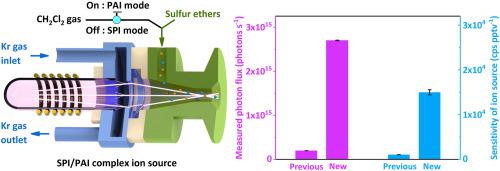Talanta ( IF 5.6 ) Pub Date : 2022-05-17 , DOI: 10.1016/j.talanta.2022.123558 Yedong Guo 1 , Haijie Wang 1 , Bo Yang 1 , Jinian Shu 2 , Kui Jiang 1 , Zhangqi Yu 1 , Zuojian Zhang 1 , Zhen Li 1 , Jingyun Huang 3 , Zhiyang Wei 1

|
Single-photon ionization mass spectrometry (SPI-MS) is an attractive analytical technique for the online detection of volatile organic compounds; however, the low photon flux of the vacuum ultraviolet (VUV) lamp commonly used in the SPI ion source and the corresponding low detection sensitivity remain a constraint to its wide field applications. In this study, a new VUV lamp-based SPI ion source was developed. By increasing the discharging volume and optimizing the configuration of the lens and ionizer, the photon flux of the VUV lamp and the sensitivity of the ion source were significantly improved. The VUV lamp output was 2.8 × 1015 photons s−1, which was focused into the small ionization zone, and the ion intensity of gaseous benzene under SPI achieved 1.7 × 104 counts per second per pptv (cps pptv−1). This ion source can also function in photoinduced associative ionization (PAI) mode by introducing gaseous CH2Cl2 to initiate an associative ionization reaction. Because of the high efficiency of the ion source, the amount of doped CH2Cl2 needed for PAI was greatly reduced (∼2.5% of that used in previous experiments). PAI exhibited an outstanding protonation effect on monosulfur ethers (CnH2n+1S). The signal intensities of the protonated molecular ions (MH+) were 46–128 times higher than those of the molecular ions (M+) produced by SPI. Since monosulfur ethers generally have lower SPI cross-sections than polysulfur ethers (CnH2n+1S2 or CnH2n+1S3), the PAI and SPI modes were selected for the online measurement of a series of mono- and polysulfur ethers, respectively. The obtained detection sensitivity of the mono- and polysulfur ethers reached 476.5 ± 1.72–2835.1 ± 99.5 and 47.9 ± 0.4–105.1 ± 2.3 counts pptv−1, respectively, in 10 s of sampling time. The corresponding 3σ limits of detection (LODs) were 0.12–0.71 and 0.06–0.14 pptv, respectively. This study provides advances in the development of a high-flux VUV lamp and a highly efficient SPI/PAI ion source, as well as an ultrasensitive analytical method for detecting sulfur ethers.
中文翻译:

基于高通量VUV灯的超灵敏SPI/PAI离子源及其在亚pptv硫醚在线质谱检测中的应用
单光子电离质谱 (SPI-MS) 是一种有吸引力的分析技术,用于在线检测挥发性有机化合物;然而,SPI离子源中常用的真空紫外(VUV)灯的低光子通量和相应的低检测灵敏度仍然是其广泛应用的制约因素。在这项研究中,开发了一种新的基于 VUV 灯的 SPI 离子源。通过增加放电量和优化透镜和离子发生器的配置,使真空紫外灯的光子通量和离子源的灵敏度显着提高。VUV灯输出为2.8×10 15光子s -1,聚焦到小电离区,SPI下气态苯的离子强度达到1.7×10 4每个 pptv 每秒计数 (cps pptv -1 )。该离子源还可以通过引入气态 CH 2 Cl 2以引发缔合电离反应,在光诱导缔合电离 (PAI) 模式下发挥作用。由于离子源的高效率,PAI 所需的掺杂 CH 2 Cl 2量大大减少(约为之前实验中使用量的 2.5%)。PAI 对单硫醚 (C n H 2n+1 S) 表现出出色的质子化作用。质子化分子离子(MH +)的信号强度比分子离子(M +) 由 SPI 制作。由于单硫醚的 SPI 横截面通常低于多硫醚(C n H 2n+1 S 2或 C n H 2n+1 S 3),因此选择 PAI 和 SPI 模式对一系列单硫醚进行在线测量。和多硫醚,分别。获得的单硫醚和多硫醚的检测灵敏度达到 476.5 ± 1.72–2835.1 ± 99.5 和 47.9 ± 0.4–105.1 ± 2.3 个计数 pptv -1,分别在 10 秒的采样时间内。相应的 3σ 检测限 (LOD) 分别为 0.12–0.71 和 0.06–0.14 pptv。本研究为开发高通量 VUV 灯和高效 SPI/PAI 离子源以及检测硫醚的超灵敏分析方法提供了进展。











































 京公网安备 11010802027423号
京公网安备 11010802027423号